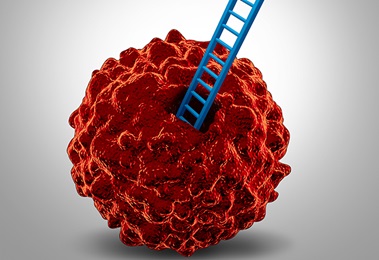Proton Therapy for Prostate Cancer
Tumors deep in the body, such as prostate cancer, can be difficult to treat with traditional radiation. Proton beam therapy may offer some advantages.
What is proton beam therapy for prostate cancer?
Proton beam therapy for prostate cancer is a noninvasive external radiation treatment that targets and destroys cancer cells by disrupting their DNA. Proton therapy can precisely target prostate tumors, while better sparing surrounding tissues and organs from radiation exposure.
Proton therapy uses proton particles that can be set to travel a certain distance into the tumor and stop. This allows radiation oncologists to deliver the right dose of radiation to different parts of the tumor to effectively kill prostate cancer.
Proton Therapy Versus Photon Radiation for Prostate Cancer
Both proton therapy and photon radiation are effective in treating certain types of prostate cancer. The two treatments have some differences, and your doctor can help determine the best option for you.
Tumor Targeting
Traditional photon radiation therapy for prostate cancer uses photons in the form of X-ray beams. X-rays release radiation along the entire length of the beam, which means they continue to penetrate into the body after passing through the tumor. This “exit dose” can potentially damage healthy tissues and organs near the prostate, including the:
- Bowel
- Bladder
- Penile bulb
- Testicles
- Rectum
- Urethra
- Bones in the pelvis and the hip joint
Radiation to these areas can increase the risk of long-term complications and of developing new cancers in the future.
In contrast to photon radiation, proton therapy more precisely targets the tumor, limiting exposure to these organs and tissues and lowering the risk of future cancers in radiated areas.
Effect on Testosterone Levels
Studies show that proton therapy does not significantly affect testosterone levels, while photon radiation treatments can lower testosterone.
Cost
Proton therapy is much more expensive than photon radiation therapy and is available only in specialized proton therapy centers. In some cases, insurance companies consider the cost of proton therapy for prostate cancer to be excessive if other treatments can achieve similar benefits. Most proton therapy centers will help you navigate insurance questions regarding your treatment.
Treating Prostate Cancer with Radiation Therapy
What types of prostate cancer can be treated with proton therapy?
Almost anyone with prostate cancer may be a candidate for proton therapy, which can treat prostate tumors with complex shapes and prostate cancer in all stages when radiation treatment is indicated, even if the cancer has spread.
Types of prostate cancer treated by proton therapy include:
- Early-stage prostate cancer
- Midstage prostate cancer
- Late-stage (locally advanced) prostate cancer
- Prostate cancer that has spread to adjacent organs or tissues
- Prostate cancer that has spread to the lymph nodes (lymph-node positive prostate cancer)
- Prostate cancer that returned after surgical removal and is detected through the prostate-specific antigen (PSA) test, indicating biochemical recurrence
In some situations, another treatment or another type of radiation may offer better or faster results than proton therapy. These situations include:
- Aggressive prostate cancer that causes symptoms: Proton therapy treatments take longer to plan than traditional radiation. Doctors may recommend traditional radiation therapy for aggressive prostate cancers so treatment can be started sooner.
- Early-stage prostate cancer: Some early-stage prostate cancers require careful monitoring, not treatment. Others may need surgery to remove the tumor and not require radiation therapy.
- Hip replacement implants, especially if they are in both hips, can affect the accuracy of CT imaging. Without clear images, it is difficult to plan precise proton beam delivery.
- Pacemakers: Proton therapy can increase the risk of a pacemaker device failure.
Proton Therapy Versus Prostatectomy
Early-stage prostate cancer can sometimes be treated by removing all of the prostate gland along with some nearby tissues — a surgery called radical prostatectomy. This comes with numerous risks and potential complications, including infertility, erectile dysfunction and urinary incontinence.
Proton therapy, in comparison, is a noninvasive procedure that does not remove the prostate or the tumor. It precisely targets radiation at the tumor to disrupt its DNA, so that it cannot grow or spread, and eventually it is eliminated. Proton therapy for prostate cancer also carries risks of erectile dysfunction and bowel and urinary problems, but it’s less likely to cause urinary incontinence and complete impotence.
Your doctor will discuss pros and cons of proton therapy, prostatectomy and other treatments for your prostate cancer type and stage.
What happens during proton therapy prostate cancer treatment?
First, the radiation oncology team needs to plan the exact radiation dose, treatment duration and position of the proton beam. You will go to the proton center for a simulation appointment, during which you will lie on the treatment table while the care team does the following.
- Takes images of your prostate
- Uses computer software to map the location of the tumor and surrounding areas
- Positions you for treatment
- Marks on your body where the beam will enter
- Fits you for positioning devices to keep your body still during treatment
Calculations and quality assurance tests will be complete about two weeks after the simulation. On the day of your first treatment, you will lie on the treatment table the same way you did during simulation. The care team will take images of the prostate to ensure you are in the right position and will then leave the room to operate the proton therapy machine.
Proton therapy treatment for prostate cancer usually takes place every weekday in regimens of four, 5.5 or seven to eight weeks, depending on the stage of the prostate cancer. Each treatment lasts about 20 minutes, and the entire visit to the treatment center takes about an hour.
You will not be under anesthesia (put to sleep) and there are no immediate effects from the treatment, so you can drive to and from the appointments. Most people do not have any restrictions after the procedure, so you can continue normal daily activities.
Proton Therapy for Prostate Cancer: Side Effects
Many patients experience fewer side effects from proton therapy for prostate cancer than from traditional radiation. When side effects do occur, they may be less severe but can last several weeks or months after treatment. They include:
- Bladder irritation
- Fatigue
- Feeling of the need to urinate or have a bowel movement often or urgently
- Skin irritation at the radiation beam entry point
Other side effects that can occur after proton therapy for prostate cancer may not show up right away. These long-term effects include:
- Erectile dysfunction
- Rectal bleeding
- Scarring in the urethra, which is a small tube that carries urine from the bladder to the penis
How effective is proton beam therapy for prostate cancer?
Studies show that success and survival rates of proton therapy for prostate cancer are similar to those of other types of radiation therapy. Some retrospective studies have shown that proton therapy has lower risk of prostate cancer returning and of secondary cancers developing after treatment. However, prospective studies are ongoing to compare results of proton therapy to those of other treatments among patients with different types and stages of prostate cancer.







